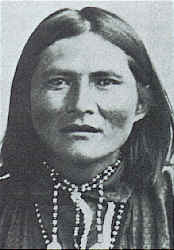
Summary
Alchesay, also known as William Alchesay, Alchisay and Alchise (Western Apache: Tsájń,[needs IPA], lit. '(the) Swollen'; May 17, 1853 – August 6, 1928), was a chief of the White Mountain Apache tribe and an Indian Scout. He received the United States military's highest decoration for bravery, the Medal of Honor, for his actions during the Indian Wars.
Alchesay | |
|---|---|
 Alchesay | |
| Native name | Tsájń (Western Apache) |
| Born | May 17, 1853 New Mexico Territory (now Arizona) |
| Died | August 6, 1928 (aged 75) North Fork, Arizona |
| Place of burial | |
| Allegiance | United States of America |
| Service/ | United States Army |
| Rank | Sergeant |
| Unit | U.S. Army Indian Scouts |
| Battles/wars | Indian Wars |
| Awards | Medal of Honor |
He tried to convince Geronimo to surrender peacefully on behalf of the United States government and remained friends with Geronimo until his death. After the wars were over he returned home to his wives and became a rancher and was active in Indian affairs.
Biography edit
He was born May 17, 1853, in a part of the Arizona Territory known as Limestone Canyon. He joined the Indian Scouts at Camp Verde December 2, 1872 and served under General George Crook in actions against an uprising of the Chiricahua Apache in the winter of 1872–1873, holding the rank of Sergeant. He was cited for gallantry, and acted as an envoy from Crook to Geronimo, trying to convince him to surrender peacefully.[1]
Crook's aide (and fellow Medal of Honor recipient) John G. Bourke described Alchesay as "a perfect Adonis in figure, a mass of muscle and sinew of wonderful courage, great sagacity, and as faithful as an Irish hound." He was an adviser to Indian agents and to President Grover Cleveland. He fought again under Crook in the campaign against the Chiricahua Apache in the Sierra Madre of Mexico in 1883 and his last military duty was as an advisor during the pursuit of Geronimo in Mexico in 1885.[1]
The Apache Wars officially ended with the surrender of Geronimo in 1886 and Alchesay returned to his family and his home. He became a successful cattleman and farmer, living for a while in Forestdale and later in North Fork. Plural marriage was an Apache custom, and was recognized by the U.S. government. Alchesay had three wives. His first wife was a young girl named Apache who bore him a son.[1] In 1871, he married Tah-jon-nay. Then, ten years later in 1881, he married Tah-jon-nay's sister, Anna.
As the leader of the Tribe, Alchesay sought better conditions for his people, and in 1887 traveled to Washington D.C. to speak to President Grover Cleveland. He met with President Theodore Roosevelt in 1909, and with Warren G. Harding in 1921. The military left Fort Apache, and in 1923, the Theodore Roosevelt Indian Boarding School was built for Navajo children. Alchesay traveled to Navajo county to welcome Navajo children to the White Mountain Apache reservation. He was instrumental in getting federal compensation for the families that were removed because of the school.[1]
He and Geronimo remained close friends until Geronimo's death in 1909. He filed for an Indian Wars pension under the name William Alchesay and resigned from active chieftainship in 1925.[1] Alchesay died August 6, 1928, at North Fork, Arizona and is buried on the Fort Apache Indian Reservation in Whiteriver, Arizona.
Honors and awards edit
Medal of Honor citation edit
Rank and organization: Sergeant, Indian Scouts. Place and date: Winter of 1872–73. Entered service at: Camp Verde, Ariz. Born: 1853, Arizona Territory. Date of issue: April 12, 1875.
Citation:
Gallant conduct during campaigns and engagements with Apaches.[2]
Other honors edit
Alchesay Canyon in Maricopa County, Arizona, near Roosevelt Dam, is named for William Alchesay.[3] Alchesay High School in Whiteriver is named in his honor. Alchesay Barracks at Fort Huachuca, Arizona, are also named in his honor.
See also edit
References edit
- ^ a b c d e Dan L. Thrapp (1991). Encyclopedia of Frontier Biography: A–F. U of Nebraska Press, 1991. ISBN 0-8032-9418-2. Retrieved February 2, 2010.
{{cite book}}:|work=ignored (help) - ^ "Medal of Honor recipients". Indian War Campaigns. United States Army Center of Military History. June 8, 2009. Archived from the original on May 24, 2009. Retrieved June 29, 2009.
- ^ "Feature Detail Report for Alchesay Canyon". United States Geological Survey. Retrieved October 18, 2019.
External links edit
- "Alchesay district history". Archived from the original on July 24, 2011. Retrieved February 5, 2010.
- "Wild West gazette". Archived from the original on October 8, 2009. Retrieved February 5, 2010.
- "William Alchesay". Hall of Valor. Military Times. Retrieved February 2, 2010.
- Tom Driebe. "Alchesay". Retrieved December 28, 2007.
- H. B. Wharfield (1969). Alchesay: scout with General Crook, Sierra Blanca Apache chief, friend of Fort Apache whites, counselor to Indian agents. OCLC 31610.
- A 1914 photo titled "Alchise" (possibly Alchesay) from the Edward Curtis collection at the Library of Congress. https://www.loc.gov/pictures/collection/ecur/item/94504736/
- James E. Cook (1971). ""You Ought to See What the Apaches Are Up To Now"".


